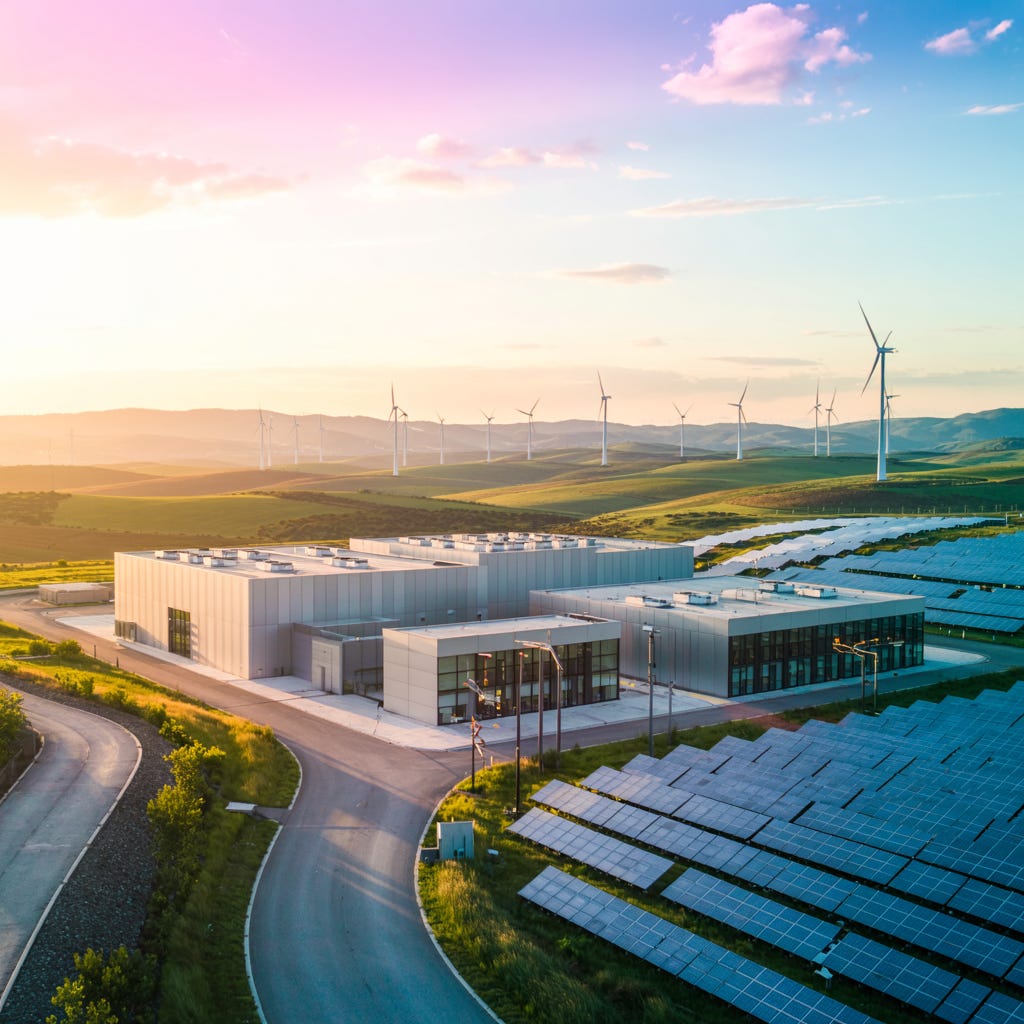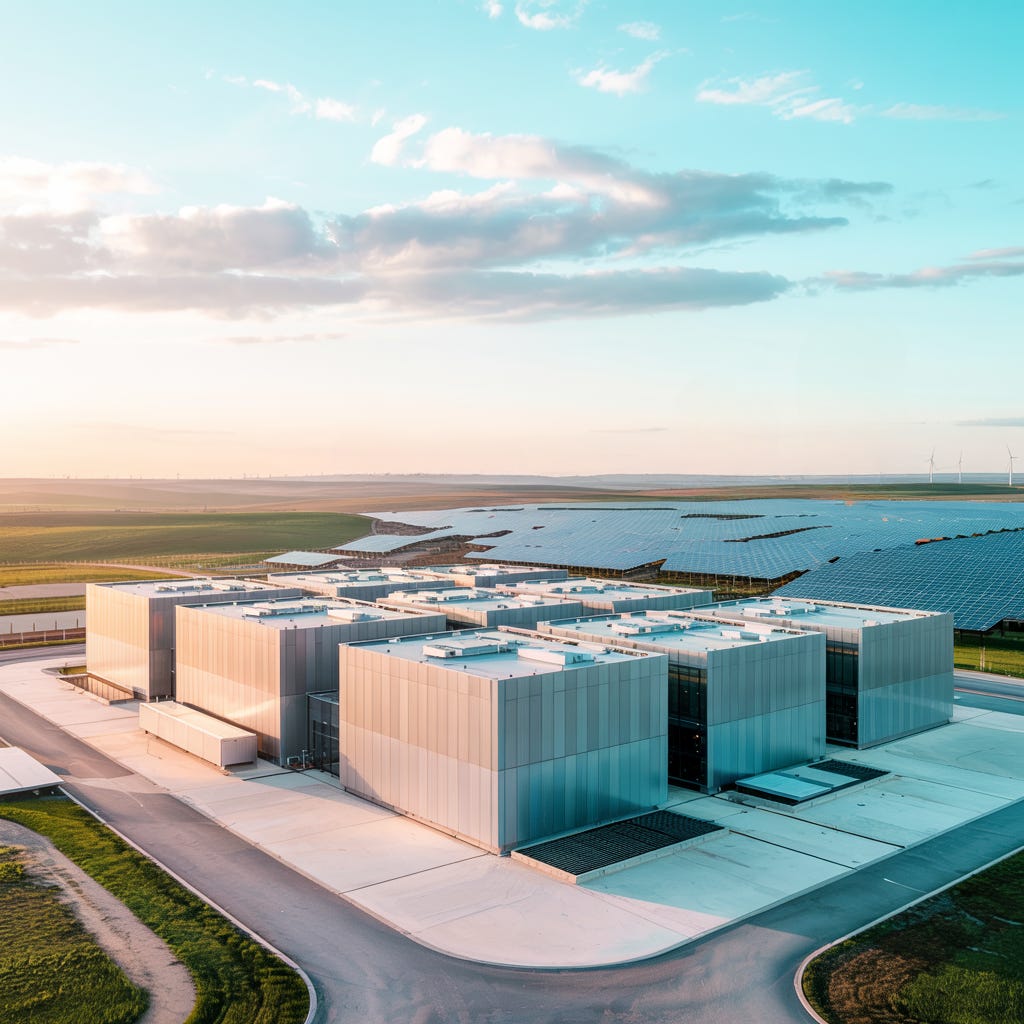The Energy Crisis AI Is Creating (And What It Means for Data Centers)
AI is outpacing the grid that powers it. The next frontier won’t be compute or chips. It’ll be who controls the electrons that keep them running.
Welcome to Global Data Center Hub. Join investors, operators, and innovators reading to stay ahead of the latest trends in the data center sector in developed and emerging markets globally.
This article is the 11th article in the series: From Servers to Sovereign AI: A Free 18-Lesson Guide to Mastering the Data Center Industry
The invisible crisis behind AI’s growth
Every conversation about artificial intelligence starts with models, data, or chips.
But the hidden story behind every AI breakthrough is energy.
AI doesn’t just think, it consumes.
Each time a model trains, it pulls megawatts from the grid. Each time it answers a prompt, it draws from the same supply that powers homes, factories, and hospitals.
The grid that supported a century of industrial growth was never built for AI-scale demand.
For the first time, digital expansion is colliding with physical limits.
How much power are we really talking about?
Today, data centers use nearly 2% of the world’s electricity. That figure sounds small until you realize how steep the curve is.
In 2020, AI workloads represented only a fraction of total consumption. By 2030, they could drive more than half of all new demand growth.
A single modern AI cluster can contain 10,000 to 20,000 GPUs and draw 20 to 50 megawatts, enough to power a small town. Multiply that across hundreds of campuses, and it’s clear why utilities are sounding alarms.
The Texas grid operator ERCOT projects peak demand will surge from 85 gigawatts in 2024 to 218 gigawatts by 2031. Most of that growth comes from AI and data centers.
When people talk about scaling AI, they picture chips and code. In reality, what needs scaling is electricity.
Why the grid is breaking
The challenge isn’t only generation, it’s transmission and timing.
New high-voltage power lines in the United States take five to ten years to permit and build.
Interconnection queues in PJM, CAISO, and ERCOT stretch well past the end of this decade. Even if capacity exists, it’s often trapped far from where demand is rising.
Hydro- and wind-rich regions like Quebec, Iowa, and the Nordics have spare supply.
But the world’s densest AI hubs (Northern Virginia, Silicon Valley, Dublin) sit on congested grids with aging infrastructure and no easy path to expansion.
Electricity has become the new geography of growth.
How data center operators are responding
Data center developers are no longer waiting for utilities to catch up. They’re building private substations, installing on-site turbines, and locking in renewable power purchase agreements measured in gigawatts.
In Virginia and Oregon, major cloud providers are quietly building their own grid interconnects. In Texas, operators are using gas turbines and battery systems to guarantee uptime.
In Europe, Google and Microsoft are experimenting with long-term solar and wind contracts to secure clean capacity decades ahead.
Some innovators are turning energy itself into a business model. Crusoe Energy converts stranded natural gas into compute power. Soluna Holdings builds wind-powered AI campuses in Morocco and Texas. DigitalBridge is investing directly in generation assets.
The line between data infrastructure and energy infrastructure is disappearing.
The new logic of site selection
For decades, location decisions started with proximity to users. Low latency meant choosing sites near major population centers and fiber intersections.
That rule is being rewritten.
Today, the first filter is energy.
Developers are prioritizing regions that can energize quickly: the American Midwest, the Nordics, Chile, and the Middle East. These areas offer lower land costs, flexible permitting, and access to renewable baseloads like wind, hydro, and solar.
In the past, operators asked “where is the demand?”
Now they ask “where is the power?”
Time-to-power has become the new measure of competitiveness. A megawatt available today is worth more than two promised next year.
When data centers become energy companies
Energy is no longer just an expense, it’s a moat.
Owning or directly contracting generation is becoming a prerequisite for survival. Operators that can control their own supply chains will move faster and de-risk their expansion schedules.
This is already reshaping business models. Developers once valued for real estate portfolios are being re-rated as integrated energy players. Capital markets now treat “energized megawatts” as an asset class of its own.
The companies that blend data, compute, and generation (not just lease space) will define the next decade of AI infrastructure.
The policy collision
Governments are caught between two competing mandates: meet climate targets and sustain digital growth.
Each new AI campus adds jobs and investment but also strains transmission systems designed for a different era. Utilities must balance industrial demand with household reliability.
Some countries are encouraging data centers to co-locate near renewable energy sources or fund new grid connections. Others are introducing moratoriums, efficiency standards, or “capacity-for-contribution” schemes where operators pay for infrastructure upgrades in exchange for priority access.
Policy is now a determinant of where AI can exist physically. Nations that move fastest to align power policy with digital expansion will attract the next wave of hyperscale investment.
What this means for investors
For investors, the shift from power-as-cost to power-as-competitive advantage changes how value is measured.
The new metrics include energized megawatts, time-to-power, and firmness of supply. A project that can energize in 18 months is worth more than one that promises more capacity three-to-five years out. Developers with direct control over their energy supply will trade at higher multiples, reflecting lower execution risk.
The next generation of infrastructure funds is already adjusting. They’re evaluating data center portfolios not only by occupancy or revenue but by the reliability and resilience of their energy strategies.
Power is the new yield curve of digital infrastructure.
A look ahead
The energy challenge will define the next stage of the AI boom. It will influence where capital flows, how facilities are financed, and which regions emerge as winners in the global compute race.
Countries with abundant renewable energy and flexible permitting will rise as new AI frontiers. Operators who treat energy as core IP will lead.
The winners won’t necessarily be those with the biggest data centers or the most GPUs. They’ll be the ones who can secure the power to keep them running.
Key takeaway
AI has turned electricity into strategy.
Every data center deal, every AI training run, and every infrastructure investment now begins with a single question: who controls the megawatts?
As the race to build AI capacity accelerates, those who master energy (not algorithms) will determine how fast intelligence itself can scale.


